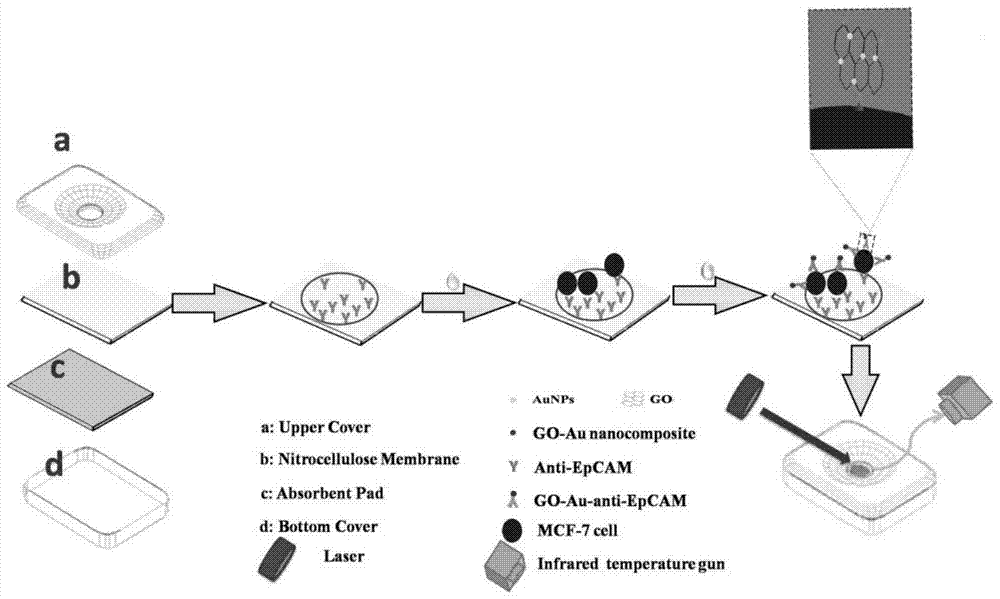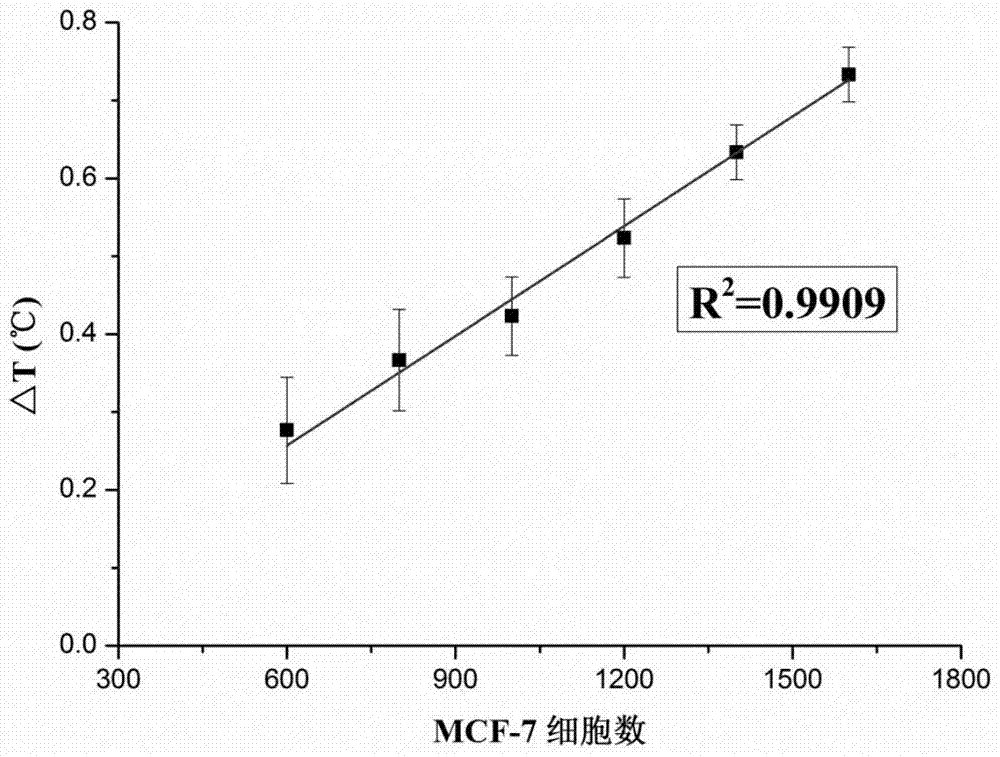A cell detection method and device based on the photothermal effect of nanomaterials
A photothermal effect and nanomaterial technology, applied in measurement devices, analytical materials, material excitation analysis, etc., can solve the problems of untimely diagnosis, limited, missed breast cancer treatment time, etc., to achieve short detection time, simple detection method, The effect of improved detection sensitivity
- Summary
- Abstract
- Description
- Claims
- Application Information
AI Technical Summary
Problems solved by technology
Method used
Image
Examples
Embodiment 1
[0039] Example 1: Preparation of MCF-7 cell detection device based on photothermal effect of nanomaterials
[0040] 1. Preparation of graphene-gold nanomaterials
[0041] Take 1 mL of HAuCl with a mass fraction of 0.1% 4 After diluting the aqueous solution to 100mL with double distilled water, transfer it to a 250mL round bottom flask and heat until the solution boils. After keeping boiling for 1 min, quickly add 3.5 mL of trisodium citrate with a mass fraction of 1% under vigorous stirring, and continue stirring until the solution turns reddish brown, then add 7 mg of graphene oxide solution until the solution turns red, and wait until the color remains stable. After the change, continue to boil and stir for 15 minutes, stop heating, and allow the solution to cool naturally. Take a certain amount of the above solution and place it in a 10mL EP tube, add 2% (m / v, unit g / mL) polyethylene glycol, ultrasonic at 211KHz for 1h, centrifuge at 8000r for 10min to remove excess graph...
Embodiment 2
[0049] The method for MCF-7 cell detection, the steps are:
[0050] 1. Cell pretreatment: Take an appropriate amount of the cell solution to be tested and put it into a 1.5mL EP tube, centrifuge at 1500r for 5min, discard the supernatant, reconstitute with 0.01mol / L PBS and then centrifuge. Repeat the above operation three times, discard the supernatant, and dissolve the centrifugal pellet with 10 μL of 0.01mol / L PBS buffer before use;
[0051] 2. Adding samples: drop the processed MCF-7 cell solution into the sample loading area on the percolation test strip prepared in Example 1, after infiltration, wash with PBST solution three times;
[0052] 3. Add 10 μL of the graphene-gold-anti-EpCAM antibody complex prepared in Example 1, after infiltration, rinse with PBST solution three times and dry;
[0053] 4. Photothermal measurement: 808nm laser irradiates the sample loading area for 60s, and the infrared temperature gun records the temperature before and after and calculates t...
Embodiment 3
[0056] Example 3: Preparation of a detection device for human small cell lung cancer cells based on the photothermal effect of nanomaterials
[0057] The preparation method is the same as in Example 1, except that the antibody added during the preparation of the graphene-gold-antibody complex is 2F1 antibody.
[0058] The method of using this device to detect human small cell lung cancer cells is the same as in Example 2. The human small cell lung cancer cell solution with known cell numbers is taken for detection, and the number of cells in the human small cell lung cancer cell solution to be tested is calculated. The recovery rate is 85.7%.
PUM
| Property | Measurement | Unit |
|---|---|---|
| quality score | aaaaa | aaaaa |
Abstract
Description
Claims
Application Information
 Login to View More
Login to View More - R&D
- Intellectual Property
- Life Sciences
- Materials
- Tech Scout
- Unparalleled Data Quality
- Higher Quality Content
- 60% Fewer Hallucinations
Browse by: Latest US Patents, China's latest patents, Technical Efficacy Thesaurus, Application Domain, Technology Topic, Popular Technical Reports.
© 2025 PatSnap. All rights reserved.Legal|Privacy policy|Modern Slavery Act Transparency Statement|Sitemap|About US| Contact US: help@patsnap.com


